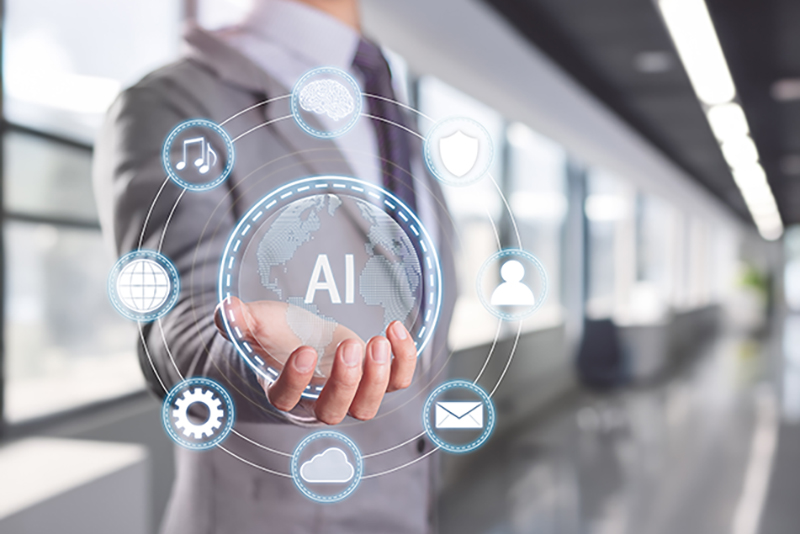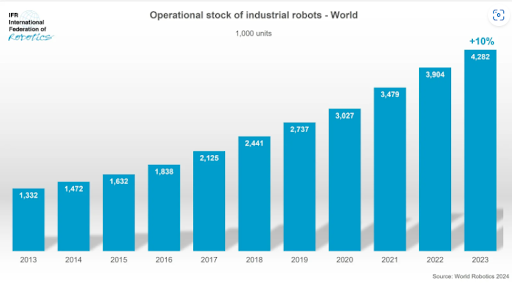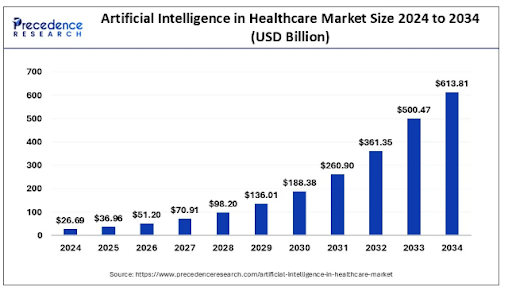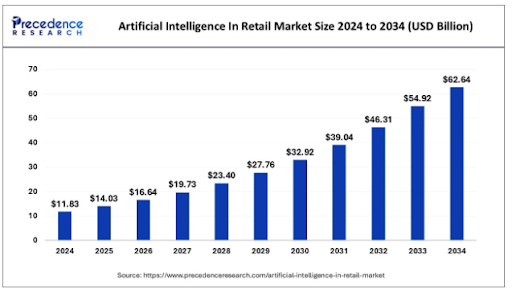The adoption of Artificial Intelligence (AI) is perhaps the most significant leap that humans have made in the past couple decade or so. In many ways than one, AI-driven business automation has changed the nature of businesses as we know it. While the basics of AI-driven automation was proposed centuries ago – as early as the times of Plato, it became mainstream only in the late 1950s, after John McCarthy held a workshop at Dartmouth on “artificial intelligence” which is the first use of the word. McCarthy also developed the first programing language for AI, LISP (List Processing), which is still in popular use.
Nevertheless, from the 50s, the developments in AI has come a long way, and with the onset of the 21st century, we have seen a drastic shift in our daily routines with AI as the driving catalyst. This could be marked as the beginning of a new industrial revolution touted as the ‘Industry 4.0’, which was triggered by the growing need for industries to replace human-centric traditional means of production and processing to a more automated one.
While ‘Industry 4.0’, with its foundation in AI, Big Data, blockchain, IoT (Internet of things), sensors and CPS (Cyber-Physical Systems, or robots), focused on reducing cost, time and labor, we are now at the cusp of the next level of industrial evolution, i.e. ‘Industry 5.0’, which leverages the advantages of its predecessor, but extends beyond just production to include all aspects of business and organizational strategies. Industry 5.0 pivots on societal values and wellbeing rather than mere economic gain, and stresses the importance of humans working along with machines to achieve the desired results.
In short, it is about how AI can enhance and compliment human efforts, with AI taking care of workflow automation, performance monitoring, issue resolutions, while humans can focus on more mission critical operations.
Let’s take a look at the future of automation with AI across business sectors:
AI in Manufacturing Enterprise Operations
The manufacturing industry has been one of the early adopters of AI automation. Robots have been in play on factory floors as early as 1960s. The International Federation of Robotics (IFR) recorded 4,281,585 units operating in factories across the globe in 2023, which is an increase of 10% from the numbers in 2022. They also claim that the annual installation exceeded half million units for the third consecutive year. Experts are of the opinion that this growth will continue as they are getting cheaper and more flexible.
Besides the use of robots, the manufacturing industry also employs AI for advanced analytics for predictive maintenance that spots anomalies in real time and reduces downtime. Also, the computer vision of AI detects microscopic defects. Another application of AI in the industry is additive manufacturing, otherwise known as 3D printing, which doesn’t require any dedicated tooling or models. This technology enables mass customization and also speeds up lead time.
According to Fortune Business Insights: “The global 3D printing market size was valued at $19.33 billion in 2024 and is projected to grow from $23.41 billion in 2025 to $101.74 billion by 2032, exhibiting a CAGR of 23.4% during the forecast period. North America dominated the global market with a market share of 41.39% in 2024.”
AI Workflow Automation in Healthcare
AI-driven business automation has found a strong foothold in the healthcare industry with its deep learning algorithms and natural language processing (NLP) applications. Prompted by increasing demand for enhanced efficiency, accuracy, and better patient care, integrating AI with existing legacy electronic healthcare records (EHR) systems brings about many advantages like reduction in workload on manual documentation, optimization of administrative and workflow efficiency, early detection of chronic diseases, enhancement of clinical decision support system (CDSS), improving billing and claims and much more.
While AI-powered diagnostics tools can analyse complex medical reports and images like MRIs and CT scans with incredible precision, AI’s virtual health assistant, powered by NLP, can offer patients personalized healthcare recommendations and can even schedule appointments or answer generic medical queries.
According to a report by Precedence Research: “The global artificial intelligence (AI) in healthcare market size was estimated at $26.69 billion in 2024 and is predicted to increase from $36.96 billion in 2025 to approximately $613.81 billion by 2034, expanding at a CAGR of 36.83% from 2025 to 2034.”
Cognitive Automation Solutions for E-commerce
E-commerce is perhaps an industry that saw a sea change in its operations model in the past couple of decades and it wouldn’t have happened without the application of AI. As people have shifted their preference from traditional brick and mortar stores to online platforms for their shopping needs, the impact of AI on e-commerce and retail personalization became more evident.
Machine learning in e-commerce platforms can easily predict buyers’ behaviors from past searches and purchases and can recommend products they would be interested in. Other than intelligent product recommendations, AI also helps the retail industry by automating logistics, pricing optimization, warehouse management, improving customer care and much more.
It is estimated that there are about 2.77 billion (33% of world population) shopping online in 2025 at any given point of time, contributing to about $6.8 trillion. And, according to a report by Precedence Research: “The global artificial intelligence (AI) in retail market size was accounted for $11.83 billion in 2024, and is expected to reach around $62.64 billion by 2034, expanding at a CAGR of 18.14% from 2025 to 2034.”
Intelligent Process Automation in the Finance Sector
AI plays a pivotal role in today’s financial market and Fintech industry. Algorithmic trading platforms have made markets more efficient by leveraging AI to analyze vast amounts of data and execute trades at lightning speed. Also, robo-advisors powered by AI algorithms can give financial guidance to individual investors to make informed decisions, thereby easing the access to financial expertise.
Because of its efficiency to handle and analyze large data sets, AI-powered risk assessment models are helping financial institutions to manage their portfolios effectively. Companies in the financial sector can also leverage AI to analyze and manage data from multiple sources to provide valuable market insights.
However, a much more critical role that AI plays is fraud detection. AI-powered systems can easily identify anomalous patterns in financial transactions, give warning and prevent fraudulent activities. AI also gives an extra layer of protection to your personal data and access through applications like facial and voice recognition, biometrics etc.
Another area of FinTech that has seen improvement because of AI is their customer service. AI interfaces like chatbots and virtual assistants can reliably interact with customers and answer basic queries, and this has helped in reducing front office and helpline costs.
As per a recent report published by the Allied Market Research: “The Global AI in Fintech Market was valued at $8.23 billion in 2021, and is projected to reach $61.30 billion by 2031, growing at a CAGR of 22.5% from 2022 to 2031.”
AI-Driven Business Automation in the Hospitality Industry
Yet another industry that benefited much with the applications of AI is the travel and tourism and hospitality management industry. AI-travel planners and self-driving cars are sure to change the way we plan our meetings, vacations or even daily commuting. It is a fact that self-driven automobiles are far from perfect as of now but the time isn’t far away when that would be our preferred mode of transportation from point A to point B.
Be it booking a flight ticket to finding an ideal beach or hill resort to stay on a weekend, the NLP-powered chatbots and virtual assistants of various travel and tourism websites have made it easy for you. Further, it can analyse your previous searches and give you recommendations hard for you to resist. It can also analyse your preferences, travel and stay history to create highly personalised loyalty programs. All these helps the hospitality business in customer retention.
AI also helps in demand forecasting and revenue optimization by analyzing market trends, competitor pricing, real-time demand and market conditions. AI can also improve the overall customer experience by improving check-in/check-out processes, managing room services, automated housekeeping, predictive maintenance, and AI-enabled events and conferences bookings etc.
AI Use in the Agriculture Sector
The United Nations predicts the global population to reach 8.6 billion by 2030, and hit almost 10 (9.8) billion by 2050. Further, a report by the Food and Agriculture Organization (FAO) states that we need to produce 60% more food in a sustainable manner to feed that kind of population. Nevertheless, the current scenario of water scarcity, climate change and others pose a big challenge to meet this requirement with traditional means of agriculture.
This calls for the need to boost productivity by means of more sustainable ways of agriculture. According to a report by Markets and Markets: “The Artificial Intelligence in Agriculture Market size is projected to grow from $1.7 billion in 2023 to $4.7 billion by 2028; growing at a Compound Annual Growth Rate (CAGR) of 23.1% from 2023 to 2028.’
AI can offer many advantages to farmers like provide real-time insights about soil quality, weather and plant health; automate irrigation, pest control, and much more to improve the overall farming process and accuracy. AI in agriculture provides various applications to farmers aimed at optimizing the efficiency of crop production such as precision farming, livestock monitoring, drone analytics, agriculture robots, and labor management.
For example, ‘Hello Tractor’, headquartered in Kenya, is a digital platform that connects farmers and tractor owners through a farm equipment sharing app. It also provides a GPS fleet management solution.
Another example is the pest monitoring and forecasting solution Trapview. It uses pheromones to attract pests, which are then photographed by a high-resolution camera in the device. Trapview has an internal database of pest species, which it uses to identify the pest, and uses location and weather data to estimate the impact of the insect on the crop and push this information as a notification to the farmers. This enables timely intervention and reduces the use of harmful chemicals, which in turn reduces crop losses.
AI-Driven Business Automation in Education
To say that AI-driven automation has changed the way learners learn and teachers teach would be an understatement. The past decade has seen an exponential growth in the adoption of AI in the education ecosystem the worldwide.
As per a report by Grand View Research: “The global AI in education market size was estimated at $5.88 billion in 2024 and is projected to reach $32.27 billion by 2030, growing at a CAGR of 31.2% from 2025 to 2030, driven by the increasing demand for personalized learning experiences.”
The application of AI in the education sector vary from classroom management to providing personalized lessons and detailed insights to research scholars. Below are some of the benefits of AI-based education system:
- Interactive learning: The gamified content and adaptive learning approach of AI is a game changer. Learners can be kept motivated and involved through interactive quizzes and simulations that respond to students’ inputs.
- Personalized content: AI can analyze each student’s learning style and pace in real time and customize educational content accordingly. This would ease the pressure on learners and let them learn at their own pace.
- Improved accessibility: Young children can benefit from AI-based educational games, while students with disabilities can receive more efficient learning experience through AI-driven assistive technologies support. For example, Notta is an AI-based software that transcribes spoken words into text for hearing-impaired students.
- Actionable insights: Because of the inherent ability of AI to process large datasets, it can collect and analyze vast amounts of educational data and track the performances of students across various metrics. This can provide actionable insights to teachers and help them to identify learning gaps and formulate the right instructional strategies.
- Automate administrative tasks: Grading, report generation and lesson scheduling eats up a lot of time of the teachers. While AI scheduling tools can help with class timetable optimization and resource allocation, software like Gradescope can enable consistent and objective grading of assignment.
- Advanced learning and development: In this age of continuous and adaptive learning, educators need to keep themselves updated, and AI can support this by recommending personalized resources and courses based on educators’ career goals and teaching needs.
- Better scalability: It becomes a challenge to attend to all when the learner base starts getting bigger. AI can easily handle this as it can handle large data volumes and still provide personalized learning.
These are just some of the applications of AI in the field of education. If employed the right way, your imagination is the limit to how AI can be used to better the lives of educators and learners.
AI Automation Shaping the Media and Entertainment Industry
The media and entertainment industry has been one of the early adapters of AI. The industry has been adept at leveraging the use of AI in media content creation and distribution, to enhance audience experience and strengthen brand presence.
According to Grand View Research: “The global AI in media & entertainment market size was estimated at $25.98 billion in 2024 and is projected to reach $99.48 billion by 2030, growing at a CAGR of 24.2% from 2025 to 2030.”
AI-driven tools like predictive analytics, customer engagement tracking, audience segmentation, and large language model (LLM), have helped the industry to enhance their services and build a more interactive user experience.
Here are some of the benefits of AI in the media and entertainment industry:
Content personalization: AI can analyze user preference from our search or browsing pattern and suggest personalized recommendations of music, shows, and movies that suite our taste. This not only helps media houses in enhancing customer engagement but also in retaining them.
Enhance production: We have seen how AI has drastically improved game designs and animated shows. Additionally, AI also enables automating audio and video editing, and help with other post-production tasks thereby reducing production time, cost and resources required.
AR and VR: The introduction of augmented reality (AR) and virtual reality (VR) has revolutionized the way users interact with content. This caters to the audiences’ need for more interactive and immersive experience.
Enhance streaming quality: Banging your head against the wall when a video you’re streaming get stuck midway for buffering is a thing of the past. AI applications in media and entertainment space can now adapt to the quality of the video and the users’ data speed to avoid buffering, or recommend to opt-out if they don’t want to compromise on the quality of the video.
Marketing and promotions: AI can analyse user data and social media trends to develop promotional materials and marketing strategies targeted for your taste. This helps media houses to reach the right audience and improve their marketing ROI.
Control distribution: AI models are adept at adhering to different regulatory guidelines concerning distribution of content across regions. This can help media houses in filtering prohibited or undesirable content for regions under various regulatory bodies. AI can also easily detect copyright violations and prevent theft of intellectual property.
AI has come to play a major role in the ever-evolving media and entertainment sector and is revolutionizing the industry even as you’re reading this. We watch live sports and shows on screen now but AI promises much more than just reducing buffering time. With the under-explored possibilities of AR and VR, we might soon be virtually present in stadiums watching our favourite sports person perform, or among audience in a stage show or live reality show cheering for our darling stars.
How DeepKnit AI Agents Can Help Bring Next-gen Automation to Your Business
Now that you have an understanding of how AI automation impacts different industries, you can start automating your business process with the help of an experienced partner.
With deep knowledge of AI and experience catering to the evolving trends, DeepKnit’s AI Agents are powerful tools that can enable digital transformation and unravel significant advantages to your business.
DK AI Agent is a revolutionary combination of advanced automation technologies and user-friendly functionality, imparting a flawless experience from integration to operation. Regardless of the industry you are in, DK AI Agents are designed to meet your ever-evolving automation needs, minus any disruptions or hassles.
Some of the benefits of AI for business transformation:
- Enhanced Accuracy
- Better Productivity
- Scalability
- Save Time
- Cost Reduction
- 24×7 Operations
Looking to give the AI edge to your business?
Check out our Custom AI Agent Development Services.
Get Started Today




